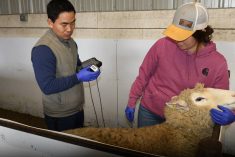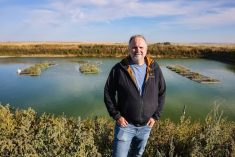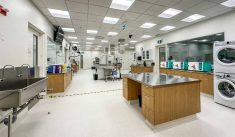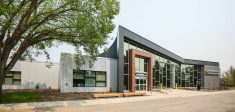Just picture it: You’ve been watching your crop get rained on all week from your kitchen window, and it’s about time to do some crop scouting to see if you need to spray.
But your farm is way ahead of you.
Soil sensors have been monitoring moisture levels, and they’ve already called for reinforcements. A drone deploys, taking pictures of your crop with its near-infrared sensors and analyzing them for disease development. The drone must have found something because your DOT sprayer starts making its way down the field.
Read Also

Farming Smarter receives financial boost from Alberta government for potato research
Farming Smarter near Lethbridge got a boost to its research equipment, thanks to the Alberta government’s increase in funding for research associations.
“Ah,” you think as you sip your coffee, watching the autonomous machine begin its spraying operation, “we caught it right on time.”
This may sound like something straight out of the ’60s cartoon “The Jetsons” — but that future is a lot closer than you might think.
“In a nutshell, DOT is a robot that represents a significant step toward autonomous field operations for broad-acre crop production,” said Joy Agnew, associate vice-president of applied research at Olds College.
“It makes a lot of sense for a farm of the future to adopt this leading-edge, paradigm-shifting technology that incorporates a growing number of mechanical and digital systems to gather information, execute tasks, and relay information to the user.
“It’s really pushing the envelope when it comes to robotics for crop production.”
Over the past growing season, the college has put DOT to work on its Smart Farm, using the made-in-Saskatchewan autonomous platform (which can be fitted with a variety of implements) for seeding, spraying, and spreading fertilizer. And as DOT does its work, the college has been working with researchers, students, and producer partners to assess the efficiency of the self-driving machine when compared to conventional equipment.
“For our first year of operations with DOT on the applied research side, we definitely did focus on the operational data collection to compare the labour, economic, and environmental advantages of autonomous ag equipment compared to conventional,” Agnew said in a recent college webinar.
Still, that work is aimed at paving the way for a Jetsons-style future — one where an algorithm uses weather station and soil sensor data to pinpoint the right time to spray. And then deploys an autonomous sprayer when the time is right.
“We’re several years away from that, and there’s a considerable amount of research and validation required to get there,” said Agnew. “But it illustrates that autonomous and automated equipment has the potential to not only address the labour shortage but also facilitate better usage of data for data-supported management decisions.”

It’s a tantalizing idea that goes beyond sipping coffee while watching robots do the work.
The bigger prize is reducing inputs while boosting quality and yield. (So in the spraying example, that could mean using less fungicide because the disease has been caught at an early stage but also getting a better outcome than if you sprayed more a day or three later.)
“Ultimately, that is what’s going to help farmers improve the productivity, profitability, and sustainability of their operations,” said Agnew.
‘Fewer educated guesses’
That’s been the real draw of DOT for Olds-area producer Jeff Carlson, who has partnered with the college to help trial the equipment.
“As we go on producing commodities, we’re always challenged to produce more with less,” said Carlson. “That’s a continual theme, and it has been through my 30-odd years of farming.
“We can use genetics, fertility programs, variable-rate application — all these other technologies, but really, in the field, there’s still the same implements. There’s still tractors pulling something with operators in them.
“So there are efficiencies there that we’re hoping to achieve. We were really keen on gathering data from an operational efficiency standpoint.”
And for Carlson’s son Josh, that could mean a future on the farm that isn’t spent behind the wheel of a tractor or a combine.
“What we’re striving for is to be able to reach a point where we can operate this equipment day and night,” said Josh. “You should be able to run it 24 hours, and one operator should be able to manage multiple DOTs simultaneously. That’s the ultimate goal.”
Even so, Josh believes the role of a farmer won’t disappear entirely — just change — as these technologies become more widespread.
“There will always be a need for farmers. It’s just a matter of making it easier for them to have the efficiencies that they need.”
Olds College student Daniel Stefner agrees.
“In the near future, I would expect things to become more automated but not necessarily fully autonomous. I think there’s a place somewhere in the middle,” said Stefner, who has been working with DOT as a research technician at the Olds College Centre for Innovation.
“I’m also expecting to see a higher integration of technology within the farm, where producers and farm managers are spending more time behind a computer desk and less time behind the workbench.”
That integration is what will allow producers “to make more informed decisions and fewer educated guesses,” he added.
“Just as GPS and auto steer have refocused our attention in the cabs of equipment, the next level of automation that DOT is bringing will enable producers to refocus their attention again on other important aspects of the operation, like agronomy, finances, and marketing,” he said.
In the meantime, the college and its partners will continue working with DOT to “support further development and validation of new implements,” said Agnew.
Machine learning
Part of that will be using additional sensors in what college officials call a ‘connected’ farm. But it also involves artificial intelligence, specifically machine learning.
One of the more prominent examples of this is the ‘See & Spray’ system developed by a Silicon Valley company called Blue River Technology, which was acquired by John Deere three years ago. It’s developed a sprayer that uses an array of cameras coupled with graphics processing units that, in turn, can access a photo library of more than one million images of weeds. This allows the “robotic nozzles” to learn what is a weed and only spray it, and not the crop.
“The cameras and computers on a See & Spray machine use deep learning algorithms that are similar to what’s used in facial recognition,” Blue River official Ben Chostner says in a company video.
“The first time we saw pigweed, the machine didn’t know what kind of plant it was. But we taught it by giving it tens of thousands of examples of that pigweed and now it’s an expert in pigweed.”
The sprayer also reports back on weed types, densities and locations allowing a farmer to tailor a herbicide mix specific to that field — a hint of the kind of work that might take up time formerly spent in the cab.
The technology, which is still in the testing phase, could cut herbicide use by 80 to 90 per cent, according to John Deere, which also says it will work just as well for fungicide and fertilizer applications.
And it’s still early days, said Agnew.
“Really, the sky’s the limit when it comes to autonomous technology, and we’ve barely left the ground at this point,” she said. “I’m very much looking forward to what the next few years will bring when it comes to autonomous ag equipment development, validation, and testing.”
But for the young farmers working with this equipment, the future really is now.
“I was walking behind the tractor as it was going,” said Stefner. “I never thought I’d be walking behind a tractor with nobody in it.”















